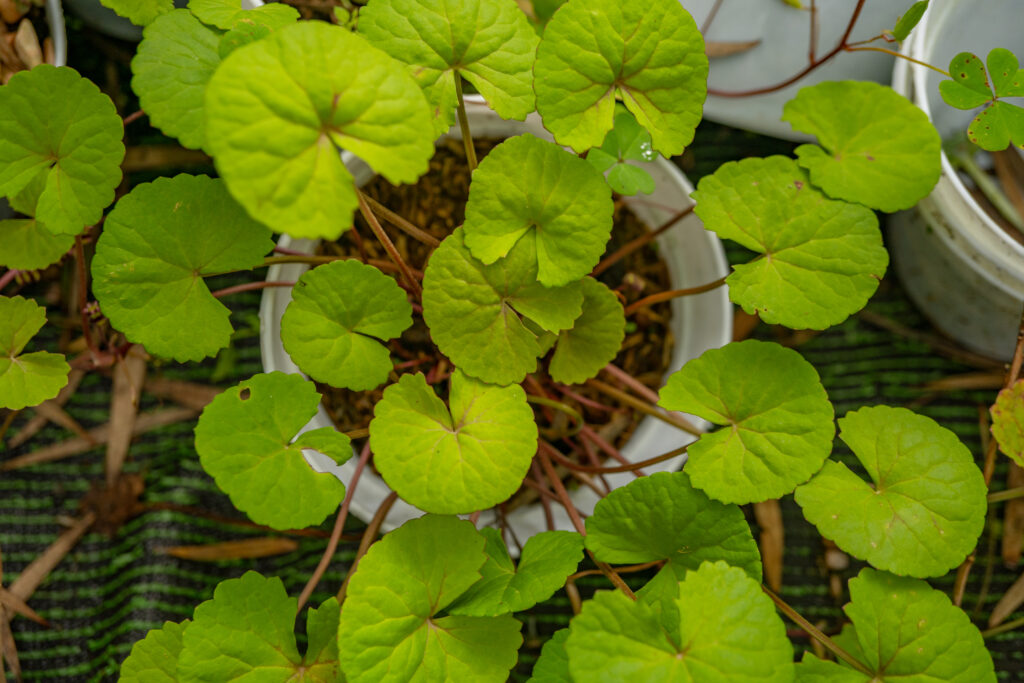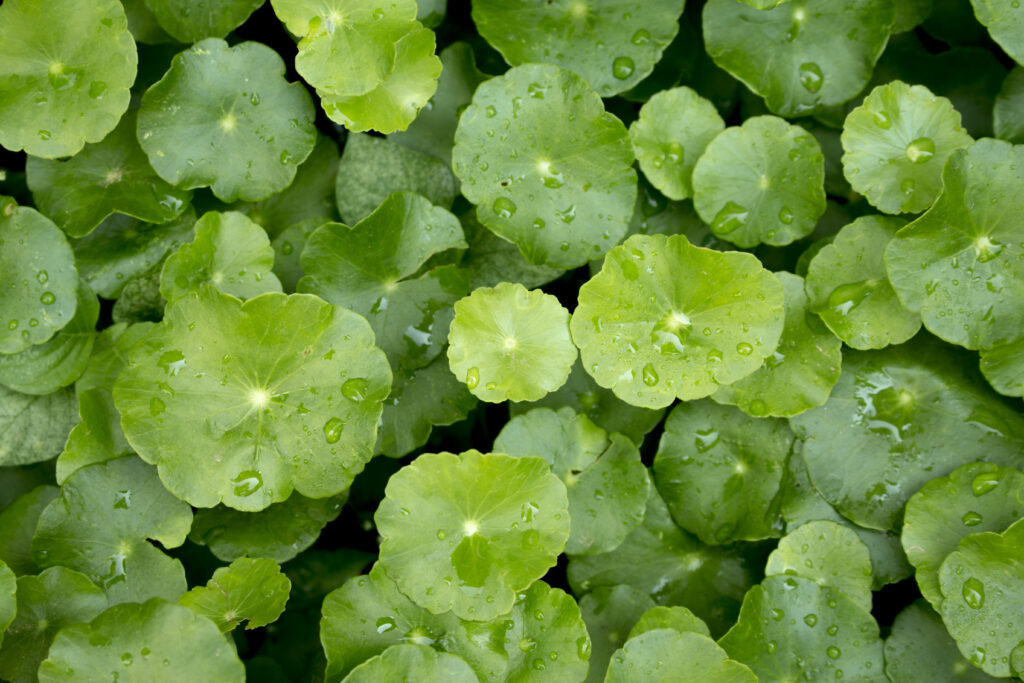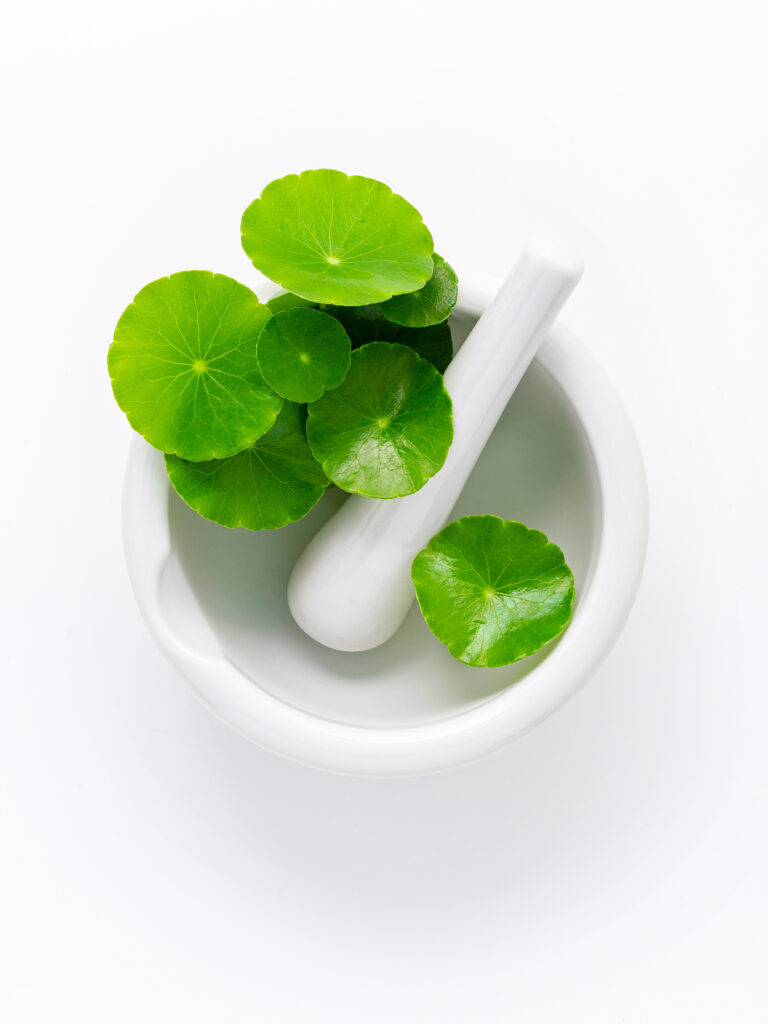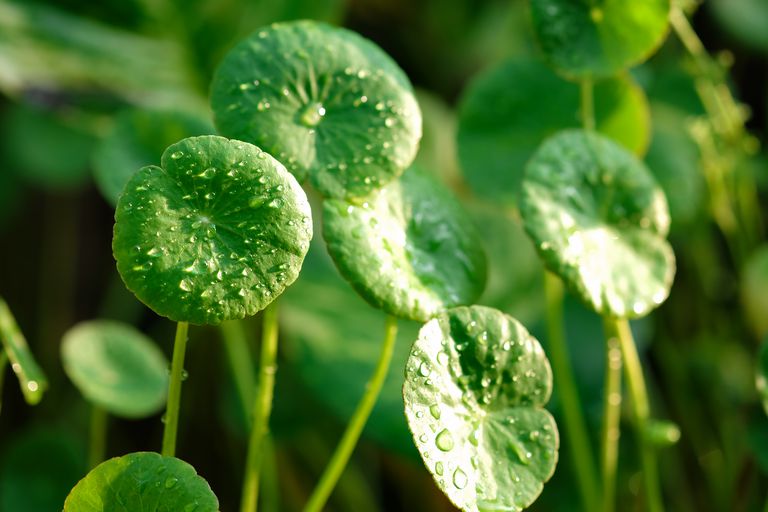Nothing about this plan advertises its highly acclaimed status in Eastern culture. Some claim that the word “Centella” comes from the Latin “Scintilla,” which means to scintillate, possibly because of the plant’s slight sheen, but the more popular etymological root is the Latin “Centrum,” which means spur of prickle, possibly referring to the flowers’ pin-like styles. The Sanskrit name “mandukaparni” means “frog-leaved,” and the English name refers to its resemblance and abundance of pennies. Its most common name (gotu kola) is the romanization of the Sinhalese word “ගොටුකොල” meaning “cone leaf.”
This plant is considered a weed in the local tropical climate of the Indian subcontinent (zone 9b+), being extremely hardy and highly invasive around streams, water pumps, pipes, and rice fields.
Of course, as a Canadian, the plant comes a bit sparser for me. While you can grow the plant from seed, keeping them moist around 9-12 inches apart, the easiest way to grow this plant in a pot is to allow the space for the plant to spread out on its reddish stolons, or runners. These individual plants do much better if they are left attached to their cord until they’ve fully rooted.
This is quite a humble look for the “cure to mortality” — “the herb of longevity” or “the fountain of life.”
The plant is common in cuisine, from dishes to teas— it’s a popular afternoon pick-me-up in Thailand, a rejuvenating salad in Malaysia (called “pegaga”), and a restorative coconut milk porridge in Sri Lanka (called “kola kanda”)— but it was more widely popularized for its regenerative qualities as a purported adaptogenic, analgesic, anti-inflammatory, antifungal/antibacterial/antiviral, diuretic and anti-cancerous medicine, and at a certain point, its usefulness has brought it to apotheotic levels.
I’ve kept a pot of gotu kola for years as an aesthetic addition to the occasional herbal teas I make from the plants around the house— the fresh leaves of gotu kola float at the top of your drink like lily pads along, and, with cute flowers (like lobelias), it can make a pretty cozy cup— but I can’t say I’ve felt the kind of life-enhancing effects that herbalists claim.
Yet there must be a reason for the universally consistent acclamations for these highly curative plants; and perhaps, to figure out what it is, we need to dig a bit deeper.

Skin-Deep
Gotu kola has grown in popularity in the beauty industry; including in Korean skin creams, which are internationally famous for their proficiency at maintaining a beautiful, youthful appearance. On the surface, this is due to the presence of saponins.
Saponins are… a subject in their own right. They’ve been studied globally, and solidified a place in herbal, pharmaceutical, and cosmetic fields— simply, saponins are a type of plant extract that contain several different compounds. Initially, I thought they were called saponins because of their relation to “sap,” but its Latin actually reads as “in soap,” and it’s commonly used to make soap because it foams when agitated (by more than verbal insults) and contains Asiatic acid (and asiaticosides), which are antibacterial, antifungal, and antiviral.
But more than the assumed functions of soap, asiatic acid is also anti-inflammatory, increasing blood flow and improving skin health, which consequently reduces signs of aging and even promotes hair growth. Specific qualities of this acid also protect the skin against cellular damage caused by free radicals and increase the elasticity and firmness of the skin’s surface; oligosaccharides moisturize the skin by creating a hydrophilic sugar chain that reduces water loss and phytosterols (which are not saponins but still exist in gotu kola) protect the skin against sun irradiation. This makes it a potential cleanser, moisturizer, and sunscreen when applied topically.
One thing to note is that members of the Apiaceae family, in which gotu kola resides, often have phototoxic furancoumarins, which irritate the skin when put in contact with sunlight, as well as cytotoxins (cancer-causing toxins). One notable example of this is hogweed, which causes blistering and swelling on contact, followed by hours of stinging pain. Fool’s parsley is another example.
There have been several reports of gotu kola causing skin irritation or dermatitis; not only are there no cases of phototoxic elements in gotu kola, it often has the opposite effects. The reports of irritation are believed to stem from allergic reactions.
But more than just a topical cleanser, saponins (specifically asiaticoside) have been praised for their healing qualities, due to their ability to stimulate collagen production and reduce myofibroblast growth (myofibroblast tissues aid the epidermal healing process but can cause severe scarring in excess). They maintain the structure of connective tissues (due to their ability to facilitate collagen and elastin), which is imperative for reinforcing the lining of veins and the female reproductive system.
This is why herbalists often use gotu kola to treat varicose veins and ease pain in menopause. In the past, gotu kola was used to treat skin conditions like leprosy, psoriasis, and eczema, as well as wounds and scars caused by cellulite or stretch marks.

Blood and Guts
When you go a bit deeper than skin-deep, though, perhaps the benefits are more disputed.
For example, just as the Asiatic acid in gotu kola improves vessel lining, it also breaks down aged red blood cells, improves cholesterol balances, and reduces urea, improving the body’s circulation. Tissue repair extends to the mucus and lining of the stomach and intestines and helps cure gastrointestinal issues like gonorrhea and stomach ulcers. It prevents the chronic inflammation of the intestines that leads to leaky gut and certain auto-immune conditions.
Through these benefits, it’s clear that gotu kola facilitates the body’s self-regulating system. On the other hand, some studies suggest gotu kola can lead to intoxicated blood and increased blood sugar; the long-term use of gotu kola increases the risk of liver damage (which is only fun in the sense that one interpretation of the plant’s Latin name translates to “Asian glow,” a symptom of liver poisoning). The diuretic aspect of the herb can drain the body of electrolytes.
The common thread between these adverse symptoms, though, is the inclusion of the word “excess.” In a lot of cases, herbalists and other practitioners will treat this herb with the respect of pharmaceutical medication, recommending several weeks of gotu kola extracts to address specific issues; for example, the recommended dosage for varicose veins calls for 4-8 weeks, though the extracts start to exhibit negative effects after around six weeks.
I’d like to cut in here to say I’ve been adding this plant to teas quite regularly, as the plant itself is extremely prolific and produces enough leaves; and while I haven’t been feeling the lifting benefits purported by other people spreading the word of the gotu kola, I also haven’t been feeling the type of negative effects others have been experiencing either. This may be because I add my own to teas, which are not nearly as strong as extracts.
It’s hard to deny, at least, that the healing qualities of the plant are consistent across cultures. It was recorded in Shennong’s Herbal Classics (in China) around 2000 years ago (in the 200s AD); perhaps its anti-inflammatory properties have earned it a reputation as a “cooling” herb, ridding inflammation, clearing damp or bleeding, and treating fever. Around 3000 years ago Sri Lankan records gotu kola as a cooling herb originating from India. In most cases, there was some mention of the plants’ gastrointestinal, epidermal, and mental benefits.
My gotu kola has been afflicted by both sunburn and aphid infestation at some point, and at each point, I’d salvaged one or two main plants from the batch to find the pot completely recovered in a matter of months. If the plant itself isn’t rejuvenating for people, it surely makes up for it in self-rejuvenating qualities.

Brains
The reputation of gotu kola gets more interesting around its psychological benefits. Quite simply, its anti-inflammatory effects combat headaches (although high doses are reported to cause nausea, dizziness, and headaches). Despite its frequent confusion with the caffeinated cola nitida (the kola nut used in Coca-Cola), or its use as a sedative (herbalists warn against intaking high doses of gotu kola, especially with other drowsy herbs like St. John’s wort or valerian), the plant is thought to improve the memory and focus. Scientists study it for its possible ability to combat the preconditions of Alzheimer’s disease, specifically because of its ability to combat oxidative damage and neurotoxicity (the antioxidant qualities also heal tissue damage and inhibit degeneration from oxidative stress), and the herb is thought to manage folic acid, improving cognitive function.
Dubbed “food for the brain” in botanical medicine, gotu kola is fabled to be the elephant’s secret to long lifespans and long memories in Southeast Asia. Indian yogis use the herb to enhance meditation, steeped in honey tea, and Sri Lankan Buddhists would eat Kola Kanda, a coconut-milk and gotu kola porridge, as a restorative meal after fasting. In Chinese culture, this plant is a supreme Shen (spiritual) & Sattva (reality enhancing) tonic, enhancing awareness.
The most interesting benefits come in the form of the plant’s facilitation of psychological rejuvenation. Officially, gotu kola is known as an adaptogen (stress reliever). Its multiplication of gamma-aminobutyric acid manages the body’s cortisol, a hormone released through stress, causing fatigue, insomnia, and weak immunity in high volumes. This, as well as sound sleep, also likely improves the body’s cognitive function and memory, as well as the aforementioned circulatory and gastrointestinal issues.
Thus, despite the aforementioned reports on drowsiness, this plant is used to treat fatigue or mental burnout (called pitta) in Ayurveda practices. Along with bacopa (Bacopa monnieri) and Ashwagandha (Withania somnifera), gotu kola is known as “brahmi,” which is generally used to treat mental ailments, such as memory loss, stress, worry, and foggy thinking which cause a loss of concentration.
Some people claim that its mental benefits can be seen in the shape of the leaf, which from some perspectives looks like a brain, though it’s hard to take seriously when the plant is named after a frog’s foot and a form of currency.
Gotu kola is also associated with general well-being. In Feng Shui, informally known as the science of home decor, gotu kola is thought to promote unity and harmony, due to its rounded leaves, and it’s placed on the Northern sides of the house to symbolize water.
this is useful advice; as if to mirror its status as a cooling plant and its natural habitat alongside bodies of water, the gotu kola doesn’t appreciate too much direct sunlight and its health drastically increases after taking it out of the grow light and taking it to the indirect light of the windows.
One myth claims gotu kola was one of the herbs carried over on a chunk of mountain the monkey king Hanuman carries all the way over from the Himalayas to Sri Lanka for Lakshman (Rama’s brother), who was injured. Like this myth, the plant is thought to strengthen relationships, as well as invoke good fortune and abundance.
Apotheosis
With its contributions toward the individual’s well-being, it’s not surprising that gotu kola is eminent in the South Asian practice, called “Ayurveda” or “Knowledge of Life” (“Ayu” meaning lifespan and “Veda” meaning knowledge). Because it strives to promote health and prevent diseases, it is thought to be a medicinal practice, but Ayurveda informs various practices to achieve a balanced lifestyle, tailored to individual circumstances and rhythms.
In this balance-focused practice, gotu kola is the herb of balance, or “sattva.” It is a “tridoshic” herb, which means it balances the three doshas, vata, pitta, and kapha— this is similar to the Chinese yin and yang, is associated with sensations like light and dark or cold and hot, and correlates partially with a person’s demeanor— and in meditative cultures, gotu kola is thought to balance the left and right hemispheres of the brain.
In a way, all of the features outlined about the gotu kola suggest balance. A lot of its purported benefits, for example, work together toward the same goal— the psychological benefits help the body’s gastrointestinal function, and the gastrointestinal function promotes psychological benefits; collagen induction increases circulation, which also improves skin health; etc— and a lot of the benefits focus on balancing the body’s harmful excesses (like myofibroblasts, cortisol, urea, and oxidative toxins) or increasing the body’s deficiencies (like collagen).
It’s interesting, then, to note that gotu kola is best known for its apotheotic reputation as a miracle herb. Fitting to the herb’s aquatic habitat (ponds and springs) and its purported benefits, gotu kola is sometimes suspected to be the universally coveted “fountain of longevity” or “fountain of youth,” a mythical spring that retains the youth of the drinker or bather, in much the way the plant’s acclaimed enhancements suggest.
Gotu kola is often referred to as “tiger herb” or “tiger grass” because of a Laotian myth in which villagers saw tigers roll in gotu kola to heal their wounds; this might also relate to the tiger skins that symbolize the attainment of ultimate truth in depictions of saints or yogis or rishis, since both gotu kolas and tiger skins are linked to mental clarity. In some cases, Brahmi, the word attributed to brain-benefiting herbs like gotu kola, refers to universal divine consciousness, which not only purports mental clarity, but an ultimate level of awareness.
The plant has been associated with claims of unnatural longevity or immortality. The most famous case of this is the historical figure Master Li Ching-Yuen (李清雲, pinyin: Lǐ Qīngyún), a Chinese herbalist, martial artist, and tactical advisor who allegedly lived past 250 years old, outliving 24 wives and bearing over 200 descendants. Although this involved some unrelated practices (“Keep a quiet heart, sit like a tortoise, walk sprightly like a pigeon and sleep like a dog”), some claim he was able to achieve this through his diet of herbs and rice wine (these herbs were: lingzhi, goji berry, wild ginseng, he shou wu, gotu kola, and others).
(Unrelated, there is one Sri Lankan folklore in which a king named Aruna takes gotu kola and has the energy to satisfy a harem of fifty women.)
Conclusion
All of these studied and supernatural benefits aside, though, gotu kola is still just a simple ground-hugging plant. It produces plain hermaphroditic flowers and red oval fruit, crawling across the ground in spindly stolons like a cluster of strawberry plants, and getting the same garden greeting as dandelions. It’s a panacea and a pandemic weed, and yet I’ve never truly encountered either of these features in the garden or kitchen.
And yet… gotu kola is one of my favorite plants to grow. It’s an extraordinarily easy plant to grow, and even without feeling its objective health benefits, there’s something quite gratifying about growing a healthy, brimming pot of lily-pad plants that can supposedly make my plain cup of tea turn into a little fountain of youth.
That’s the beauty of the gotu kola plant. Like an actor who gets a standing ovation at the end of a play, the gotu kola has an enthusiastic place in its local culture, and it’s become something else through the folklore and reputation it embroidered around itself over the years. Yet it doesn’t matter if every emotion an actor invokes is true; what matters is the emotion he invokes.

